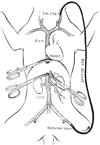Reconstructive problems in canine liver homotransplantation with special reference to the postoperative role of hepatic venous flow
- PMID: 18979655
- PMCID: PMC2729187
Reconstructive problems in canine liver homotransplantation with special reference to the postoperative role of hepatic venous flow
Abstract
The homologous canine liver has been transplanted to recipient animals in which total hepatectomy and splenectomy have been performed. The longest survival after placement of the liver homograft was 20 1/2 days. Protection from hepatic ischemia for as long as 2 hours was obtained by cooling the donor liver to 10 to 20 degrees C. The arterial supply was restored through a hepatic artery-aortic pedicle which was removed in continuity with the liver and anastomosed to the descending aorta of the recipient. Internal biliary drainage was established. The volume of venous flow transmitted to the transplanted liver has been shown to be an important determinant of success. When this was excessive, as when both the portal and inferior caval flows were directed through the liver, hepatic and splanchnic beds. When the portal flow was normal or reduced, outflow block rarely occurred. An attempt has been made to relate the development of outflow block as it occurred in the transplanted liver to other circumstances, including hemorrhagic shock, in which similar phenomena have been observed.
Figures








References
-
- Arey LB. Throttling veins in the livers of certain mammals. Anat. Rec. 1941;81:21.
-
- Bernhard WF, McMurrey JD, Curtis GW. Feasibility of partial hepatic resection under hypothermia. N. England J. M. 1955;253:159. - PubMed
-
- Child CG. The Hepatic Circulation and Portal Hypertension. Philadelphia: W. B Saunders Co; 1954. pp. 90–106.
-
- Deysach LJ. The nature and location of the “sphincter mechanism” in the liver as determined by drug actions and vascular injections. Am. J. Physiol. 1941;132:713.
MeSH terms
Grants and funding
LinkOut - more resources
Full Text Sources
Other Literature Sources
